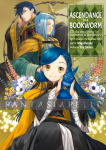Playground Worlds is a collection of articles on role-playing games by leading researchers, artists and other experts. The book documents the theory and practice of the Nordic role-playing scene – one of the most vibrant in the world – and presents numerous methods and techniques that are directly applicable to larp design and production. It also offers a peek into some Anglo-American role-playing cultures.
The book is divided into three sections. Community and Journalism includes articles on role-player communities written particularly with an eye for approachability. Art and Design covers role-play as the product of a creative process, exposing philosophies and intentions behind specific role-playing works while providing advice and guidance for prospective designers. The Research and Theory section focuses on recent advances in analytic and academic thought on role-play.
Journalism & Community
The Role-Players’ School: Østerskov Efterskole
Malik Hyltoft
Østerskov Efterskole is the first school in Denmark to base its teaching primarily on role-playing. The pedagogy of the school changes both the role of teacher and pupil and presents a very different view of teaching. This article describes the methods used at Østerskov Efterskole as well as the school life experienced by the pupils. It gives preliminary assessments of the feasibility of the applied methods, both based on observations from school life and on the few statistical facts obtainable. Finally, it compares the empirical experience of the school with previous articles on role-playing based teaching.
Leave the Cat in the Box: Some Remarks on the Possibilities of Role-Playing Game Criticism
Jussi Ahlroth
Robin D. Laws wrote in 1995 an article titled “The Hidden Art: Slouching Towards A Critical Framework for RPGs”. In the article, Laws claims that “Criticism of the actual role-playing game experience is the Schrödinger’s Cat of art criticism”, referring to the critic’s participation in the artwork she is to criticise. This essay addresses that conundrum by looking at the relationship between subjectivity and objectivity in criticism. A twofold division between text and-performance is proposed to see what the conditions under which a critic can criticise a role-playing game are. The conclusion is that in terms of criticism, the major problem is not the role of the critic, but of the other players. Finally, it is pointed out that the critique as a genre of writing might expand to other forms of writing when it comes to role-playing game criticism.
The Dragon Was the Least of It: Dragonbane and Larp as Ephemera and Ruin
Johanna Koljonen
The international fantasy larp Dragonbane (July 27th – August 4th, 2006) was unprecedented in ambition, the promises of the organisers including a functional village, working magic and a life-size fire-breathing animatronic dragon. In this essay, Johanna Koljonen describes some of the production’s challenges and successes, in the context of a wider discussion on how and why larps should be documented.
Producing A Nice Evening
Anna Westerling
This is an account of how A Nice Evening with a Family was created. When you create a larp, you build not only a game, but also a large organisation . You need to think about how that organisation can be optimal in order to foster a creative environment. I’ll touch on different aspects of this process in this article, such as creating a vision, recruiting an organisation and planning the financing and marketing of a game. It is my opinion that once we start to debate the managerial side of organising larps, the quality of our games will improve as we develop methods of organizing that enable us to look after the creative forces in the organisation . This article is also a documentation of my journey, the story of one larp. I share it hoping that it will broaden your views on larp organisation.
Design for Work Minimization
Kåre Murmann Kjær
Rarely does a group of organisers start creating a larp with the intention of disappointing the players. However, it happens that a larp is not realised exactly as the organisers intended and led the players to believe, which in turn leads to disappointments. In vthis article I will propose a design philosophy, Design for Work Minimization, which larp organisers can use to realise their larp with less work without compromising their vision or the quality of the larp. By reducing the workload, the chances of successfully organising the larp will increase. I will argue why this design philosophy can be helpful, and I will describe tools that can be used to realise this design philosophy.
The Children of Treasure Trap: History and Trends of British Live Action
Role-Play
Nathan Hook
This article discusses the historical and current trends across mainstream British larp, from its beginning up to the present today. It charts the twists in the development of larp focusing on the action larp tradition – the style that includes some amount of physical action such as foam weapon combat.
Art & Design
Frail Realities: Design Process
Justin Parsler
This paper discusses the design philosophy that inspired the UK live action role-playing game Frail Realities, and looks at how that philosophy was realised. This is not an attempt to instruct people on how larp games should be created, but rather shows how one such game was created as a case study to exemplify the early design process. Along the way, many of the tropes common to UK larps are discussed because they are held in common with FR or because FR broke the common mold.
High Resolution Larping: Enabling Subtlety at Totem and Beyond
Andie Nordgren
This article introduces the idea that we can describe game interaction in terms of resolution.and describes some of the methods used in the larp Totem to achieve “high resolution” game interaction. These techniques handled conflict resolution, love making, character creation and ensemble construction, building upon the methods developed in earlier Nordic larps.
Walking the White Road: A Trip into the Hobo Dream
Bjarke Pedersen & Lars Munck
On a warm autumn morning, six hobos began the most important journey of their life: To bury their best friend and greatest love. What needed to be done was clear to them, and as the journey took them closer to their goal, they could see their own salvation peak at the horizon. This article describes the preparations and execution of a larp co-created by all players and the experiences and techniques used to make a truly life changing game.
Adventurous Romanticism: Enabling a Strong Adventurous Element in Larp
Katri Lassila
This paper presents the work of Katri Lassila and Laura Kalli, a duo who has been developing a new style of live action role-play – Adventurous Romanticism – for the past four years. The Kalli & Lassila style is all about reproducing the feeling of childhood play while using classical literature and contemporary popular culture as inspiration. The four larps written and produced in this style have been played in Finland during 2003-2006.
Exhuming Agabadan
Matthijs Holter
The reality game Agabadan was an experiment in decentralised play, in which the content was provided by the players. Players created their own world views and interacted with each other through common and distributed rituals and gatherings based on those world views. The decentralized model and processes used turned out to have unforeseen vulnerabilities, and over one third of the players dropped out of the game. The game provided strong subjective experiences for those who were able to follow through.
The Nuts and Bolts of Jeepform
Tobias Wrigstad
Jeepform is a style of freeform role-playing that stresses the importance of the meta-play, transparency and tailoring the techniques to emphasise the story. It has been likened to improvisational theatre, psychodrama and performance art, and been called “what theatre might become” as well as “freeform role-playing done right.” This article is a personal introduction to jeepform, its background and how it differs from freeform, and some jeepform ideas and techniques interleaved within the rest of the text with a tiny bit of analysis sprinkled on top. In a sense, this is a partial ingredients-slip from the jeepform kool-aid bottle.
Behind the Façade of A Nice Evening with the Family
Anders Hultman, Anna Westerling & Tobias Wrigstad
Larp allows us to experience stories in a very powerful and realistic way. However, the physical restraints of time and space constrain the storytelling. In A Nice Evening with the Family a handful of techniques and methods borrowed from freeform role-playing and theatre were used to enhance the experience.
Stupid Stories: Using Narrativism in Designing Agerbørn
Jonas Trier-Knudsen
This article describes the design of the Danish larp Agerbørn, which attempts to realize the narrativist ambition of telling stories. The underlying question is whether or not larps can be used as a narrative medium, but the style is practically oriented so that organizers can use elements of the design.
Levelling the Playing Field and Designing Interaction
Troels Barkholt-Spangsbo
This article provides practical advice on and concrete examples of how to design larps. It offers a terminology for talking about different kinds of social contracts: simulation rules, regulatory rules, behavioural rules and mise-en-scènic rules serve different purposes in larp design. This paper uses Eirik Fatland’s work on interaction codes, and connects them with various kinds of social rules.
The Age of Indulgence
Juhana Pettersson
Role-playing games are a way to do things you want to do, but wouldn’t in ordinary life. In this essay, I discuss role-playing as the art of indulgence, of playing games as a way to fulfil desires, based on several indulgent larps and tabletop role-playing campaigns.
Parlor Larps: A Study in Design
John H. Kim
The term parlor larp is the name for a series of published larp scenarios from Shifting Forest Storyworks. It referred more generally to the format: a larp scenario playable in a single room, with prewritten characters and minimal preparation, to be finished in a few hours. It is a case study in how to make larps accessible to inexperienced players. I analyze the design and play of these games on several levels, based on the play of nine games of this format, including five I directed and one I wrote. There are several levels of analysis: the formula for a distribution of characters, the arrangement of in-game action within a limited scope, the write-ups of characters which is split between given information and questions for the player, and the conflict resolution mechanics including physical, emotional, and social.
Research & Theory
24 Hours in a Bomb Shelter: Player, Character and Immersion in Ground Zero
Heidi Hopeametsä
A player enters the fictional world of larp through a character. However, it is possible to immerse also in other aspects of the game, such as the physical surroundings, the story, or the challenges the game offers. I approach immersion as the way the player engages in a game when pursuing the optimal experience of flow (a concept introduced by Csikszentmihalyi), which can be achieved via these different aspects. I use the larp Ground Zero as an example. The game was a distressing experience, which was nevertheless considered to be positive and valuable by the players. It therefore provides a good case study for discussing immersion, the roles of the player and the character, and experiences which are simultaneously real and fictitious.
We Are the Great Pretenders: Larp is Adult Pretend Play
Erling Rognli
There are extensive similarities between larp and the pretend play of children. The relation between these activities is proposed to be a matter of developmental continuity rather than mere resemblance. This is further considered to be of central importance to future larp research, and of great possible utility for larp design.
Are You the Daddy? Comparing Fantasy Play in Children and Adults through Vivian Gussin Paley’s A Child’s Work
Andreas Lieberoth
Children play games, and so do many adults. What we often fail to realise is how directed and negotiated pretend play usually is, even among the smallest children. Case studies from Vivian Gussin Paley’s A Child’s Work (2004) are used to exemplify how children use techniques similar to adult role-play, such as defining characters, negotiating diegetic details, and ongoing mobilisation of new content. In this paper, such similarities are used to explore the phenomena “scripting” and “representational negotiation”, and venture a few notes on similarities and differences between children’s pretend play and 21st century adult role-play.
Kaprow’s Scions
J. Tuomas Harviainen
This article re-introduces a way of looking at live-action role-playing as an artistic and possibly ideological descendant of an earlier expressive form, the Happening. In it, I will go through rules set for such events by Allan Kaprow in 1966, analyze those rules and compare them to the conventions of larps. Additionally, I will suggest new ways of looking at larp as art and on viewing earlier theories on larp as performance.
Key Concepts in Forge Theory
Emily Care Boss
Underlying much of a surge in independent role-playing game publication is a body of role-playing game theory referred to as Forge Theory, or the Big Model. This and related concepts were formulated through discussion on online fora, particularly at one called Haephestus’ Forge. Play and design of the games also informed its development. These ideas offer an outline of the structure of role-playing and describe techniques used in table top and other role-playing games. The following is a summary of the background and key concepts of this theory.
Broadcast Culture Meets Role-Playing Culture
Marie Denward & Annika Waern
The production Sanningen om Marika is a rare example of a production that combines traditional broadcast culture with the participative culture fostered primarily within the larp community in the Nordic countries. Swedish television collaborated with The Company P to produce this alternate reality multiplatform media production. The result was a spectacular and controversial production offering online and live action role-playing experiences in parallel with traditional TV drama. This article focuses on the differences between the production cultures of two companies, and how it affected the experience they produced together.
We Lost Our World and Made New Ones: Live Role-Playing in Modern Times
Gabriel Widing
The aims and aesthetics of live-action role-playing are rooted in modernity. This article contextualizes larp as a strategy of distancing oneself from the boundaries of modern society. Larps produce autonomous spaces where the social relation of capital and the laws of the nation-state cannot apply. This theory of larp as exile from modernity explains why conservative and revolutionary impulses coexist within the subcultural practice of larp; both encompass a wish to escape the alienation of modernity. My thoughts derive from continental philosophy of the 20th century when the dark sides of modernity were more obvious than they seem today.
Fantasy and Medievalism in Role-Playing Games
Lars Konzack & Ian Dall
This article examines how medievalism has influenced fantasy and fantasy role-playing, and how medievalism relates to the historical Medieval Times. The starting point is to define fantasy and get a better comprehension of the Medieval Times and medievalism. This is then compared to wellknown medievalist fantasy tabletop role-playing games. The aim is to create a solid foundation for improving the sub-creation process of designing fantasy role-playing games in general.











